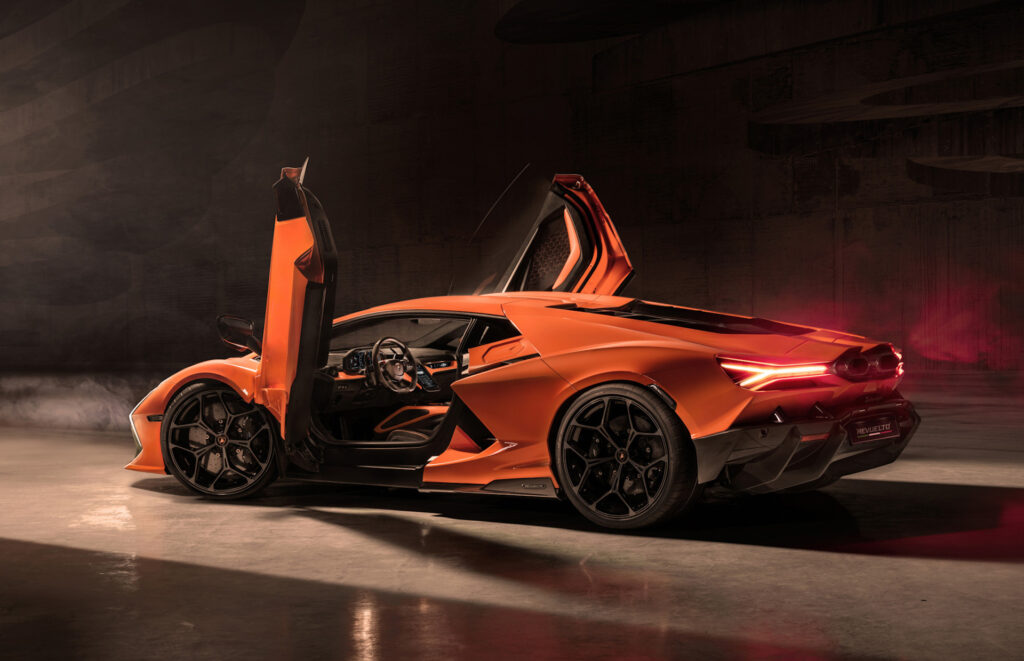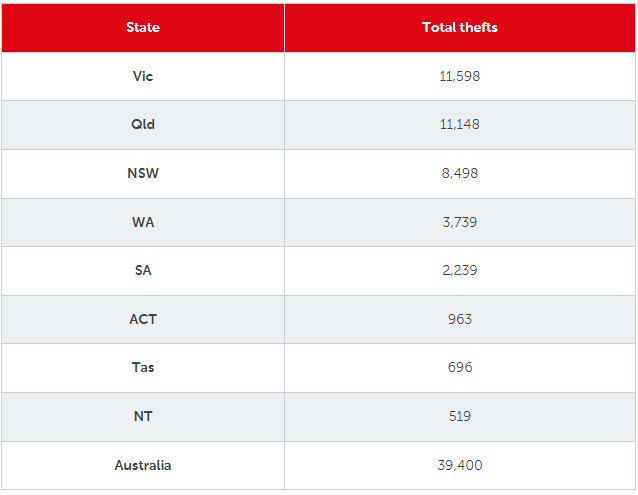
We’ve seen the teasers, the tech breakdowns and the spy shots, and here, finally, is the full lowdown on Lamborghini’s new LB744 hybrid supercar, including its name. It’s called the Revuelto after a Spanish fighting bull, though it also means “scrambled eggs” in the same language, which is not lost on Lamborghini as it launches its first ever full production vehicle that mixes dual power sources.
As only the sixth new V12-powered Lamborghini sports car in 60 years it would still be a big deal if Lamborghini had done nothing besides drape a new skin over the 12-year-old Aventador. But the LB744 is so much more than that. It introduces several Lamborghini firsts and gives us an indication of how Italy’s most outrageous car company is going to navigate the next few years, both in terms of design and engineering.
In case you’ve missed the earlier build-up stories the main thing you need to know is that Lamborghini’s top-tier supercar is still powered by a V12 engine. Better still, it remains a turbo-free zone to keep the soundtrack and throttle response as pure as possible. The 6.5-liter L545 V12 is an evolution of the motor fitted to the Aventador, but massaged to produce 814 hp (825 PS) and 535 lb-ft (725 Nm) of torque, making it Lamborghini’s most powerful road-going 12-cylinder engine yet.
Related: New Lamborghini LB744 V12 Flagship Features A ‘City’ Mode Limited To 178HP
For reference, the punchiest of the outgoing Aventadors, the LP780-4 Ultimae, only made 769 hp (780 PS), so the Revuelto is already ahead before we’ve even got to the hybrid system. That comprises of three electric motors: two 148 hp (150 PS) units in the nose driving the front wheels and a third electric motor of the same spec housed with the new eight-speed dual-clutch transmission that helps drive the rear wheels.
The V12 is only hooked up to the rear axle so the front motors give the Revuelto all-wheel drive, offer torque vectoring capabilities and make the car a front-wheel drive 178 hp (180 PS) EV in town when the City mode is selected. All of which means the Revuelto is a far more serious hybrid than the limited edition Sian, whose use of a supercapacitor for energy storage was interesting, but only offered a feeble 34 hp (34 PS) power boost to its V12 via one motor placed inside the transmission and no available EV-only mode.
First Lamborghini With More Than 1,000 hp
Combine the petrol and electric power stations together when the red mist descends and you’ve got a total of 1,001 hp (1,015 PS). Activate launch control and the Revuelto storms to 62 mph (98 kmh) in 2.5 seconds, to 124 mph (200 kmh) in less than 7 seconds and on to a limited top speed of 217 mph (350 kmh) compared with 2.8 seconds, 8.7 seconds and 221 mph (355 kmh) for the old Ultimae. Those numbers put Lamborghini’s in the same league as its closest rival, the V8-powered 986 hp (1,000 PS) PHEV SF90 Stradale: 2.7 seconds, 6.7 seconds, 211 mph (340 kmh).
The 3.8 kWh battery charges in 30 minutes using a 7 kW supply, or can be charged in just six minutes using the V12 as a generator. But the pack’s location under the transmission tunnel has forced Lamborghini to make its biggest layout shift since the Miura gave way to the Countach in the early 1970s. Most senior-league mid-engined cars have their engine tucked up close to the seats and the gearbox behind that combined with a differential to drive the rear wheels. But starting with the Countach, every V12 Lambo supercar featured the reverse, a bit like a Porsche 911’s drivetrain, but shunted forward. The transmission was housed under the tunnel and connected to the differential on the other side of the V12 sandwich via a small propshaft.
This time though, Lamborghini has adopted the more usual layout with the exception of the gearbox, which is turned through 90 degrees to keep the powertrain compact. Ferrari employed a similar combination of longitudinal engine and transverse gearbox on the 348 and F355, as did Lamborghini on the track-only Essenza SCV12. The F355, you might remember, introduced the supercar world to the paddleshift transmission, a fairly clunky single-clutch gearbox not a million miles away in terms of tech or feel from the one in the Lamborghini Aventador. But almost a decade after the arrival of the Huracan introduced dual-clutch technology to the Lamborghini lineup, the Revuelto also gets smooth-shifting DCT, though the V12’s transmission is apparently lighter and even faster than the one fitted to its little brother.
More Carbon, More Attitude
The combination of V12 power and hybrid tech should give the Revuelto modern refinement and performance without losing too much of that classic Lamborghini V12 supercar character, and the company’s design department appears to have have been channelling the same spirit. The visual links to the Aventador are clear, and of course the scissor doors make another appearance. But the Revuelto looks leaner and more athletic than the car it replaces, and the extensive use of Sant’Agata’s trademark Y-motif in the DRLs, the side air intakes and the rear lights makes it even more clearly identifiable as a Lamborghini.
Could Lamborghini design boss, Mitja Borkert, and his team have gone wilder with the styling? Sure, and you might think they should have done. This isn’t a controversial or boundary-pushing design like the original Countach was, though it’s far more advanced with its used of carbon fiber now including the front subframe as well as the passenger cell. But it will probably age gracefully and you can’t grab an eyeful of the rear view with those oil barrel-sized 345/30 ZR21 rear tires, the two hexagonal tailpipes ready to spit fumes in your face, or the fully-exposed engine nestling in the valley between to the rear buttresses, and tell us it lacks presence.
Though it’s not clear from the supplied images, the Revuelto has a new active rear wing whose position can be altered either manually or by the car depending on which driving mode is selected, giving a choice of high downforce or low drag settings. Other aero tricks include a shaped underbody and aggressive rear diffuser that contribute to a 33 percent increase in front downforce and 74 percent improvement in rear squish versus the Aventador Ultimae. Unfortunately, downforce isn’t the only thing pushing the tires into the pavement. Lamborghini quotes a dry weight of 3,907 lbs (1,772 kg) compared with 3,417 lbs (1,550 kg) for the Aventador Ultimae, and you can probably add 5-10 percent to that for a curb weight. This thing is heavy.
Three Screens And 13 Driving Modes
If anything, the changes inside are more radical than those outside, the freestanding 12.3-inch digital instrument cluster and 8.4-inch portrait infotainment screen giving a vaguely McLaren look to the interior and removing almost all traces of parent company, Audi. Lamborghini says those two screens, plus the third 9.1-inch digital strip ahead of the passenger are controlled by one brain that ensures they all look and operate the same way. It’s even possible to “swipe” information from the central screen to either of the others.
The gear selector with its u-shaped reverse lever and the slightly chintzy flip-up cover for the starter button are familiar from the Aventador, but the steering wheel and the 13 different driving mode configurations it controls are new for the Revuelto. Lambo claims the wheel is inspired by the yoke in the company’s Squadra Corse race cars, which seems a bit of a stretch. But the Revuelto’s does feature two rotary controls let you toggle between Città (City), Strada, Sport and Corsa modes to tweak the V12 machine’s character to suit the situation.
Related: Lamborghini Shows Off Aventador Replacement’s Carbon Chassis Tech
Città priorities EV running, Strada keeps the V12 engaged, but the transmission and adaptive dampers remain comfort-biased, and more focused Sport offers three sub-modes (Recharge, Hybrid and Performance) and up to 895 hp (907 PS). Want the full four-figure horsepower experience? Of course you do, and for that you’ll need to select Corsa, which bypasses the Recharge setting for the unambiguously-named Performance mode to unlock the full 1,001 hp.
All of those buttons and modes should help you get the most our of a Revuelto on your favorite track or twisty road, but they’ll also give owners plenty to fiddle with while they’re cruising at a walking pace around cities and can’t unleash more than a quarter of the power available. They’ll also be able to enjoy Amazon Alexa, SiriusXM 360L satellite radio (in the U.S.), over-air updates, LED matrix headlights and a complete safety package for the first time on a Lamborghini supercar that includes lane departure warning, blind-spot monitoring, adaptive cruise control and rear cross-traffic alert. The days of sitting on the door sill of your Countach to reverse it out of a parking bay are long gone.
More Power, But A Bigger Price

But the spirit of that Countach lives on. And so, thankfully, does the idea of a Lamborghini with a naturally-aspirated V12. These days, Lamborghini’s flagship is no longer the fastest or the craziest looking mid-engined car in the game, its place taken by $2.5 million hypercars. But for around a quarter of that price (exact numbers TBC, but likely to be around $650k /£450k, making it 30 percent more expensive than the Aventador Ultimae) the Revuelto probably has a nice niche carved out. The Ferrari SF90 Stradale is a great car, but let’s be honest, wouldn’t you rather have a V12 and scissor doors?
And the LB744 is just the start, of course. In the coming years it’ll spawn roadster and SV variants, but what do you think of the standard Revuelto? Should Lamborghini have been braver with the design or is this just about your perfect supercar? Drop your thoughts in the comments section below.
#1001HP #Lamborghini #LB744 #Revuelto #PHEV #Hit #MPH #Seconds













